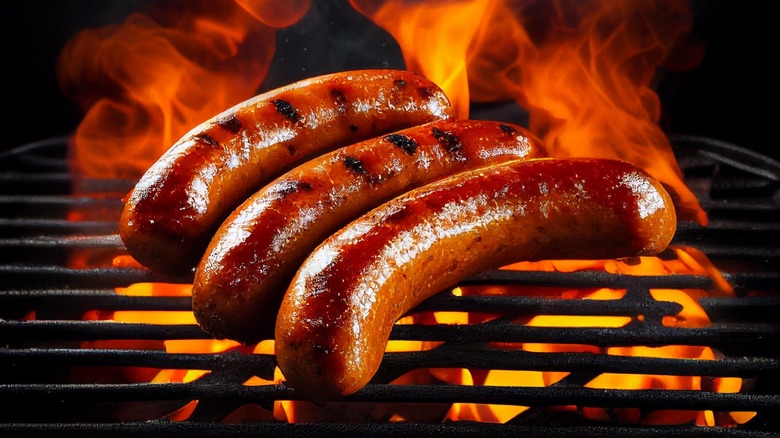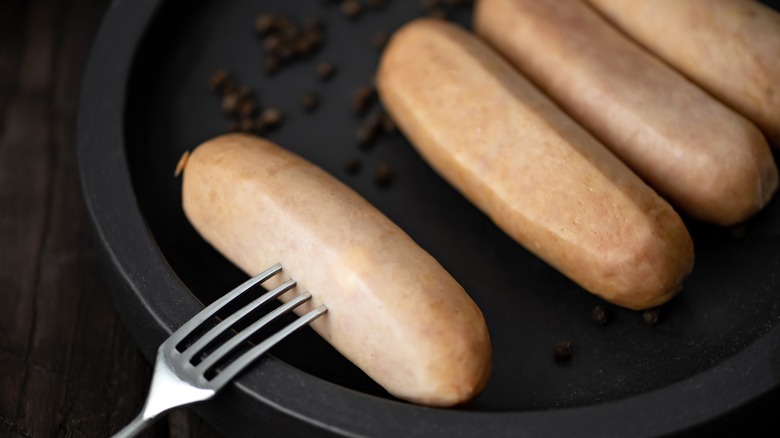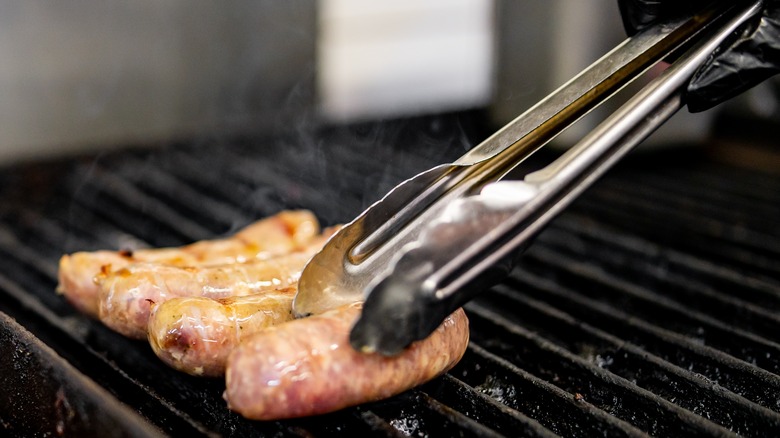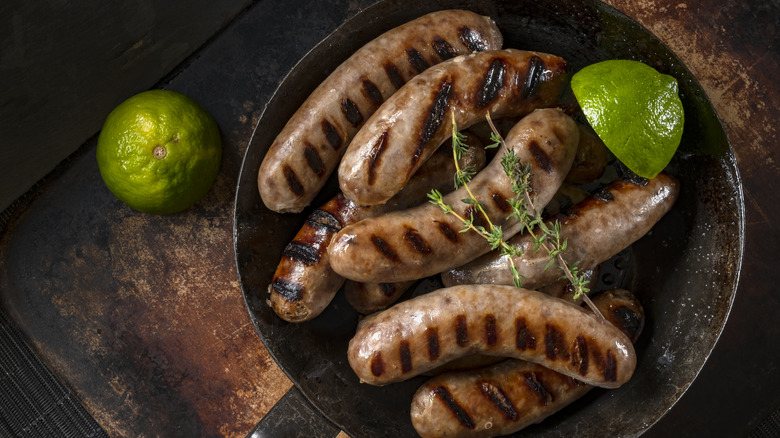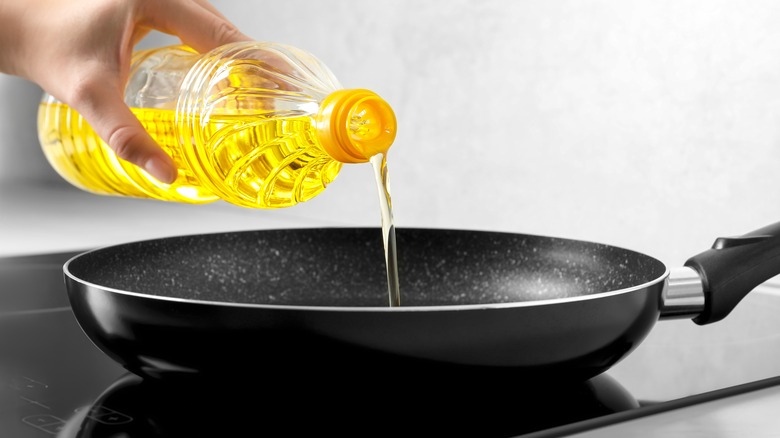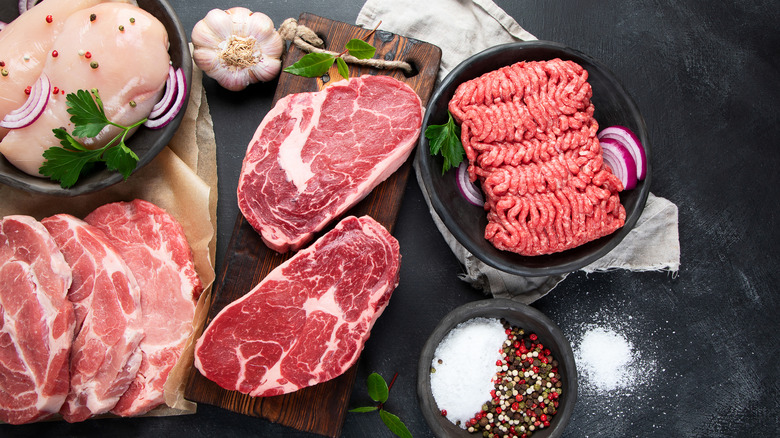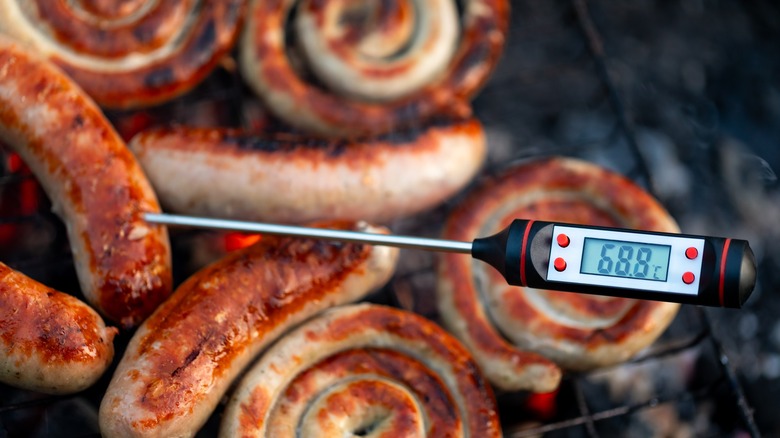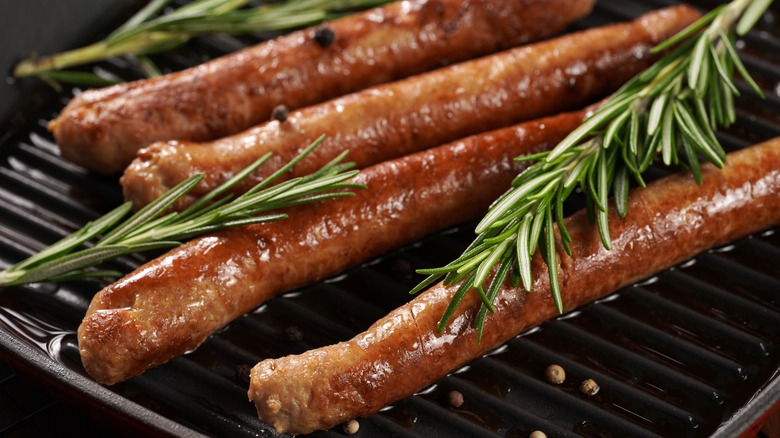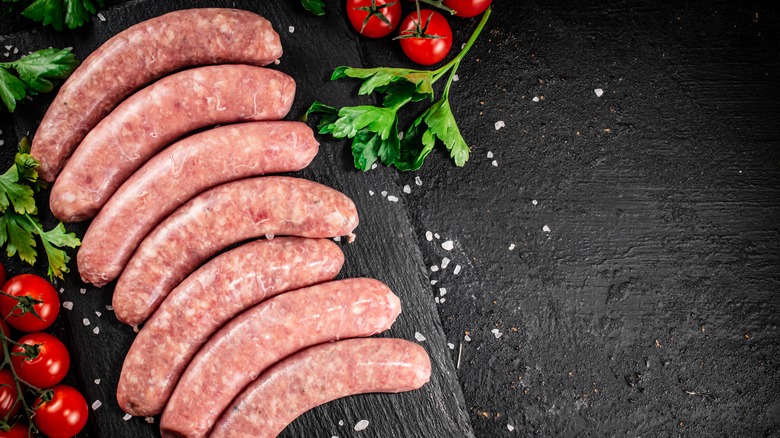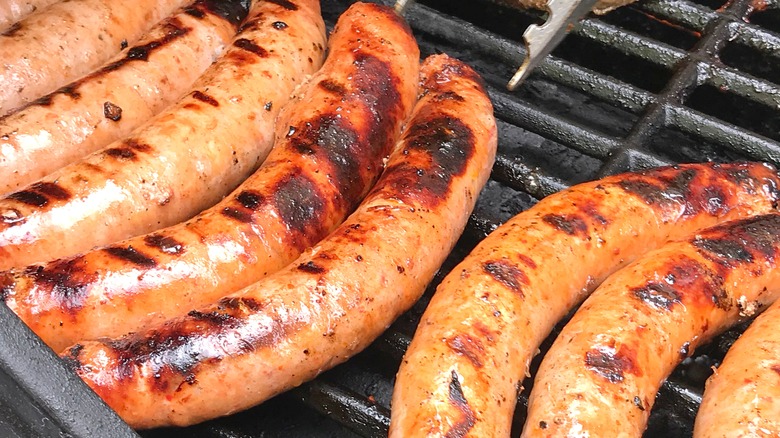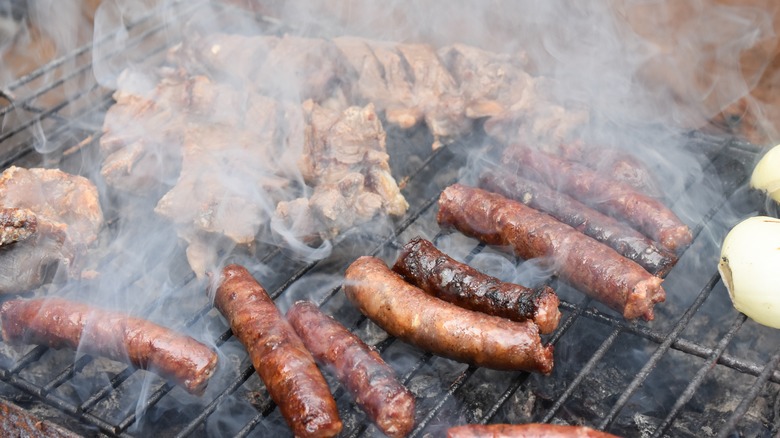Sausage Cooking Tips And Tricks You'll Wish You Knew Sooner
Cooking sausages seems a fairly straightforward task for most home cooks, and the majority of us have whipped up a few for a hearty breakfast or garden party. However, cooking sausage perfectly takes a bit of skill, and achieving a juicy middle with a crispy exterior can sometimes be frustratingly difficult.
To find out the most useful tips to help home cooks make the most of their sausages, we consulted four experts to get their advice and explore the common pitfalls that may be sabotaging your efforts.
Will Brady, executive chef at The Sipp on South Lamar; Erica Blaire Roby, Food Network's "Master of 'Cue" champion and pitmaster; James Llorens, grilling expert and ambassador for chargriller.com; and Lamar Moore, executive chef at Bronzeville Winery in Chicago are all highly experienced when it comes to cooking sausages and have shared their expert advice on how to prepare them with just the right amount of char.
From keeping the skins intact to deciding whether to oil the pan, we will explore the tips that can make the difference between a successful barbecue and a burnt disaster. So grab your spatula — and tongs — and let's dive in.
Never prick your sausages before cooking
There is a myth when it comes to cooking sausages that you should prick them before cooking to prevent them from exploding. However, according to professional chefs, that is the last thing you want to do. When asked if home cooks should prick their sausages before cooking them, pitmaster Erica Roby said, "Definitely not! Pricking sausages serves no purpose other than letting the juices escape and drying out the protein! A quality sausage with good casing will not explode." Chef Will Brady agrees: "Never prick the casing of sausage when cooking; you will lose all of the juices and flavor of the sausage."
If your aim is to have your sausages as juicy and succulent as possible — and it should be — then pricking them before cooking is a definite no-no. James Llorens has another reason for not slicing through the sausages at the start of cooking. "You should not prick the sausages when cooking, not because it will dry them out," Llorens explains, "but to avoid them from bursting out the casing."
So now we know. The sausage casing is there to protect the meat and keep all the delicious fat and juices inside, and pricking holes in it is not going to improve your sausages in any way. Put the fork down to keep the skins intact and all the flavor inside.
Use tongs to turn your sausages
If you have seen your favorite celebrity chef turning sausages with tongs on a cooking show and wondered whether you need to bother doing the same, we have the answer for you. While it is easier to simply grab the nearest fork to do the job, your sausages will not thank you for it. As we know, pricking the sausages, either deliberately or accidentally, will allow precious juice and fat to escape, and since fat equals flavor, you do not want to do that. Chef Will Brady recommends using tongs as the best option: "Tongs are best for turning sausages because you'll avoid piercing the casing and losing the sausage juices and flavors."
If you are tempted to reach for a metal spatula or fish slice that has sharp corner, you may want to reconsider that, too. "Try not to use anything sharp that will pierce the sausage casing while cooking," says chef Erica Roby. "Tongs are a great option for turning!"
Of course, professional chefs have access to a wide variety of kitchen tools, allowing them to opt for the perfect one, but sometimes, as a home cook, you simply have to use whatever is at hand. James Llorens tells us, "I'm a tongs type of guy when making sausages and don't use a fork unless I really have to, but sometimes, a fork is all that's available, and you have to just go with it. Just try not to prick it while cooking, only when it's done."
Cook sausages on a medium heat
When cooking meat, it can be difficult to know how hot to have the pan or grill to allow it to cook through without drying out. Undercooked meat is obviously a big concern when you're cooking meals for your family, but you still want your sausages to be moist and flavorsome. Chef Erica Roby has guidance to help you strike the balance and keep them as juicy as possible. "I always cook sausages on a medium heat or indirect fire on the grill so they cook evenly," Roby explains.
If you're lucky enough to be cooking on an offset grill, which will allow you to use both direct and indirect heat to cook your sausages, grilling expert James Llorens has advice to give you the best possible results. "Cook them at low to medium heat and then when internal temperature is at about 160 to 170 degrees. I then bump up the heat to medium-high heat and place them directly over the fire to char."
Though it may be tempting to crank up the heat on your pan to cook your sausages as quickly as possible, it is clear that using a medium heat is the key to making sure you don't burn the outside before the interior is cooked. This will give you the confidence that the meat is both safe and appetizing.
Use little or no oil
When cooking with a skillet or griddle, many of us may automatically add oil to the pan as it heats up to prevent food from sticking and create a beautiful crust on many foods. However, with high-fat ingredients such as sausages, you may want to think twice before sloshing the oil around. As you heat the meat, the sausages will leach their own fat in the pan, and in addition to the oil you have added, this can make them greasy or even cause them to burn if the oil is too hot.
Chef Will Brady is a fan of using a dry pan and letting the sausages create their own cooking fat: "I prefer not to use oil; I let the sausage's fat render under medium heat." Nevertheless, a couple of our experts are in favor of adding a little oil because it can help to have some lubrication in the pan at the start of cooking. Chef Erica Roby says, "I was raised to always add light oil just to keep the sausages turning and moving during the cook."
James Llorens acknowledges that cooking on the stove needs alternative techniques to his favorite method of grilling. "When cooking sausages in a cast iron pan [or] skillet, I have different techniques that are different than I do versus grilling," he says. "I add a coat of olive oil to the pan/skillet at medium heat." If you choose to add oil to your pan, make sure you use it sparingly.
Choose the right meat for making your own sausages
If you want to take your sausages to the next level, consider making your own. It may be a challenge, but it will be worth the effort if you have the time to prepare them. The beauty of making your own sausages is that you can customize them with whatever flavors you enjoy — and that includes choosing what type of meat to use. Most sausages are made from either pork or beef, but you can use venison, duck, chicken, or even a blend of different meats. In fact, Chef Will Brady says that "Any meat is suitable for sausage-making." So why not try something a bit different if you want your sausages to stand out?
Of course, pork is a classic for a reason, and if you want to use it, you can spice your sausages up with a bit of chili heat. "I like a standard spicy pork sausage or an Italian sausage," Brady admits. But even if you choose an alternative meat as the star of your filling, you should still add pork fat. It has the perfect melting point and will impart loads of flavor to your sausages.
Remember that meat is the not the only component of sausages, and you can add flavor and texture to them by adding fruits, herbs, and spices. Pork and apple, and chicken and thyme are both delicious options that will stand in contrast to the taste of store-bought sausages.
Make sure your sausages are properly cooked
When cooking your sausages, you are aiming for a light brown crust on the outside that will tell you that the exterior is perfectly cooked, but what about the inside? How can you tell from the outside if the meat is cooked all the way through? Undercooked meat poses a health risk, so it is crucial to know when your sausages are ready to serve.
Chef Will Brady suggests that, for home cooks, it is not worth the risk of guessing if the meat is done. "As a chef, you learn when they are done by color and texture. But for a home cook, I suggest a meat thermometer," he says. "Always cook your sausage to the proper temperature of the meat it's made of."
Using a meat thermometer allows you to precisely check the internal temperature of your sausages, so you can be certain if they require further cooking. According to the USDA, if your sausages contain only red meat such as beef, pork, or lamb, they need to be cooked to an internal temperature of at least 160 degrees Fahrenheit. If there is poultry present such as chicken or turkey, this rises to 165 degrees Fahrenheit.
If you do not have access to a meat thermometer, you will need to cut the sausages open and check the inside. If it is fully cooked, the meat should have a uniform gray or brown color without any pink. However, the USDA states that the only way to know for certain if your meat is safe is to use a meat thermometer, so you should consider investing in one.
Rest your sausages after cooking
If you are a steak lover, you know how important it is to rest the beef after cooking to allow the juices to reabsorb into the meat and keep it moist, but do sausages need the same treatment to keep them deliciously juicy and tender? We asked the experts for some insight into whether it's okay to tuck into your sausages straight off the grill.
"Let your [beef] sausages rest for 2-5 minutes so the internal juices and fat settle back into the meat and give you those juicy bites we all crave," says chef Erica Roby.
Chef Will Brady doesn't exactly leave them to rest but still waits a minute or two before serving. "Not necessarily," he says, "but let the sausage sit for a few minutes to allow for the meat to relax, and of course, cool off!"
On the other hand, James Llorens is in favor of seizing the day (or the sausage in this case) and skipping the resting stage altogether. "I don't rest, I remove and enjoy," he says. "I like them right off the grill!"
So, if you have the patience and aren't feeling too famished, leave your sausages for a few minutes to help keep them juicy and mouthwatering. But if you simply can't resist, it won't be a culinary sin in the same way as it is for steak, so go ahead and enjoy them piping hot if you must!
Choose quality ingredients
Whether you are buying store-bought sausages, sourcing them from a farmer's market, or making your own at home, considering the quality and quantity of the meat is crucial for both your health and flavor. Many commercially produced sausages are packed with fillers that reduce their meat content significantly, and sometimes contain nitrates or nitrites to extend their shelf life. Since both nitrates and nitrites are connected with increased risk of bowel cancer, selecting the highest quality sausages or meat possible is essential if you want the healthiest products.
In terms of flavor, the difference is significant between high and low-quality products, too. When asked how the quality or percentage of meat affects the sausage, chef Will Brady says, "Exponentially. Only make sausages from the highest-quality products available."
Breadcrumbs or rusk are necessary in making sausages to create the correct texture, but the more meat they contain, the better eating experience you will have. If you are making your own, remember to include plenty of high-quality fat, as this is what gives them flavor. As a rule, 20 to 25% fat is a good ratio for tasty sausages with an ideal texture. Remember to also add plenty of herbs and spices to the mix to boost the seasoning even further.
Choose the best grilling techniques
Cooking in the sunshine on an outdoor grill is a joy, but it requires some extra care to guarantee chargrilled sausages that are still moist and juicy. Too much time over a naked flame will spell disaster for the skins, and the meat might not be cooked through.
James Llorens shared his preferred method of cooking for those who have access to an offset smoker. "My favorite way to make sausages is on my Char-Griller offset smoker using the main grilling area by offsetting the sausages from my fire using lump charcoal and a single piece mango smoking wood for a lingering smoke flavor to add to the sausages," he says. "Be careful because leaving them over the fire for too long, the juices can burst out of the sausage casing. If this happens just be cautious and remove it from the fire using tongs."
Chef Lamar Moore, executive chef at Bronzeville Winery in Chicago and Masterbuilt ambassador, prefers cooking sausages on his Masterbuilt Gravity Series Charcoal Grill and Smoker to achieve those great grill marks and enhanced flavor. "Let the sausage rest for a few minutes on a higher rack to finish the cooking process," he advises.
When cooking sausages on a grill, indirect heat is your friend. Limited exposure to an open flame will give you that delicious charred flavor. Keep the meat turning to cook it evenly, and enjoy the wonderful taste of smoky sausages with juicy insides.
Add smoke for extra flavor
If you love smoky notes, then grilling your sausages is the perfect way to add that distinctive taster to your meat. Chef Lamar Moore has a pro tip for using a grill with sausage: "Add some smoke chips for even more flavor."
Depending on what sort of flavor you want to add, there are different types of wood chips available. Hickory is one of the most popular options for smoking and is a great all-around choice. It has a distinctive smoky taste with a hint of sweetness. It will complement your sausages perfectly, giving them that typical barbecued taste.
For a bolder flavor, try using mesquite instead. It is stronger than hickory, so it could overwhelm delicate meats, but your beef or pork sausages should be able to handle it. For something a little different, try a fruit wood such as cherry. It will create a subtle note and will work well with most meats.
If smokiness is a quality you enjoy in your sausages, try experimenting with different wood chips to create a variety of flavors to enhance the meat. Whether you like a subtle whisper or a brash and bold smokiness, finding the right type of wood chip will upgrade the taste of your sausages.

